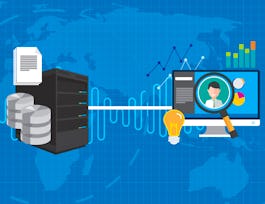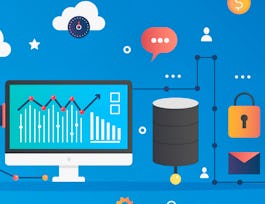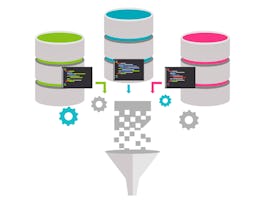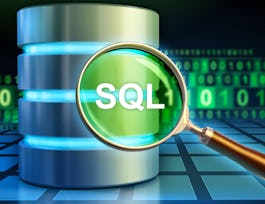Are you ready to dive into the world of data engineering? In this beginner level course, you will gain a solid understanding of how data is stored, processed, and accessed in relational databases (RDBMSes). You will work with different types of databases that are appropriate for various data processing requirements.


Introduction to Relational Databases (RDBMS)
This course is part of multiple programs.
Taught in English
Some content may not be translated


Instructors: Rav Ahuja
52,863 already enrolled
Included with 
Course
(519 reviews)
90%
Recommended experience
What you'll learn
Describe data, databases, relational databases, and cloud databases.
Describe information and data models, relational databases, and relational model concepts (including schemas and tables).
Explain an Entity Relationship Diagram and design a relational database for a specific use case.
Develop a working knowledge of popular DBMSes including MySQL, PostgreSQL, and IBM DB2
Skills you'll gain
Details to know

Add to your LinkedIn profile
13 assignments
Course
(519 reviews)
90%
Recommended experience
See how employees at top companies are mastering in-demand skills

Build your subject-matter expertise
- Learn new concepts from industry experts
- Gain a foundational understanding of a subject or tool
- Develop job-relevant skills with hands-on projects
- Earn a shareable career certificate


Earn a career certificate
Add this credential to your LinkedIn profile, resume, or CV
Share it on social media and in your performance review

There are 4 modules in this course
In this module, you will first learn about the fundamental aspects of data structures and file formats, along with the differences between relational and non-relational databases. You’ll explore various types of data models and discuss fundamental concepts in database management. Additionally, you’ll explore Entity-Relationship Diagrams (ERD) along with their components and relationships. You will also gain expertise in diverse database topics. Finally, you’ll gain a clear understanding of Db2 and PostgreSQL.
What's included
14 videos3 readings4 assignments3 plugins
In this module, you’ll explore the types of SQL statements, like Data Definition Language (DDL) and Data Manipulation Language (DML). You’ll learn how to create, modify, and manage tables using DDL statements and understand data movement utilities for efficient data loading and management. Additionally, you’ll dive into key database objects such as schemas, primary keys, foreign keys, and indexes, gaining insights into their roles in data organization, integrity, and retrieval. You’ll also understand the importance of normalization for reducing redundancy and ensuring data consistency, while also understanding various constraints within the relational model to maintain data accuracy and reliability.
What's included
11 videos2 readings4 assignments3 app items4 plugins
In this module, you will learn about the fundamental aspects of MySQL and PostgreSQL and identify Relational Database Management System (RDBMS) tools. You will explore the process of creating databases and tables and the definition of keys, constraints, and connections in MySQL. Additionally, you will discover important processes in PostgreSQL using command line, pgAdmin, and views. Moreover, you will gain essential skills such as database loading techniques and insights into securing sensitive data and streamlining data retrieval.
What's included
7 videos2 readings4 assignments6 app items
In this module, you will navigate the database design process, refine your practical skills, and understand essential steps. You will discover the role of Entity Relationship Diagrams (ERDs) and get an opportunity to engage in a hands-on database design lab, where you will use your theoretical knowledge to create databases. As you progress, you will receive an optional final assignment and project submission stages. For those seeking an advanced challenge, a final project using Db2 is available. A glossary is available for quick reference to key terms used throughout the module.
What's included
1 video2 readings1 assignment1 peer review2 app items2 plugins
Recommended if you're interested in Data Management
Why people choose Coursera for their career




Learner reviews
Showing 3 of 519
519 reviews
- 5 stars
74.37%
- 4 stars
18.54%
- 3 stars
3.82%
- 2 stars
1.72%
- 1 star
1.52%
New to Data Management? Start here.

Open new doors with Coursera Plus
Unlimited access to 7,000+ world-class courses, hands-on projects, and job-ready certificate programs - all included in your subscription
Advance your career with an online degree
Earn a degree from world-class universities - 100% online
Join over 3,400 global companies that choose Coursera for Business
Upskill your employees to excel in the digital economy
Frequently asked questions
Access to lectures and assignments depends on your type of enrollment. If you take a course in audit mode, you will be able to see most course materials for free. To access graded assignments and to earn a Certificate, you will need to purchase the Certificate experience, during or after your audit. If you don't see the audit option:
The course may not offer an audit option. You can try a Free Trial instead, or apply for Financial Aid.
The course may offer 'Full Course, No Certificate' instead. This option lets you see all course materials, submit required assessments, and get a final grade. This also means that you will not be able to purchase a Certificate experience.
When you enroll in the course, you get access to all of the courses in the Certificate, and you earn a certificate when you complete the work. Your electronic Certificate will be added to your Accomplishments page - from there, you can print your Certificate or add it to your LinkedIn profile. If you only want to read and view the course content, you can audit the course for free.
If you subscribed, you get a 7-day free trial during which you can cancel at no penalty. After that, we don’t give refunds, but you can cancel your subscription at any time. See our full refund policy.





